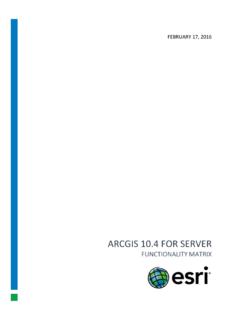Transcription of Application Layer Functionality and Protocols
1 10/11/07 10:11 AM Page 63. CHAPTER 3. Application Layer Functionality and Protocols Objectives Upon completion of this chapter, you will be able to answer the following questions: How do the functions of the three upper OSI What are the file-sharing processes that use model layers provide network services to peer-to-peer applications and the Gnutella end-user applications ? protocol? How do the TCP/IP Application Layer Protocols How do Protocols ensure that services running provide the services specified by the upper on one kind of device can send to and receive layers of the OSI model?
2 From many different network devices? How do people use the Application Layer to How can you use network analysis tools to communicate across the information network? examine and explain how common user applications work? What are the functions of well-known TCP/IP. applications , such as the World Wide Web and e-mail, and their related services (HTTP, DNS, DHCP, STMP/POP, and Telnet)? Key Terms This chapter uses the following key terms. You can find the definitions in the Glossary. data page 67 scheme page 76. source device page 67 IP address page 77. Domain Name System (DNS) page 68 domain name page 77.
3 Request for Comments (RFC) page 68 network address page 78. syntax page 70 resource record page 78. session page 71 DNS resolver page 78. client page 72 nslookup page 78. server page 72 query page 78. daemon page 73 cache page 79. peer page 75 authoritative page 81. 10/11/07 10:11 AM Page 64. 64 Network Fundamentals, CCNA Exploration Companion Guide plug-in page 82 Dynamic Host Configuration Protocol (DHCP). page 87. HTTP page 82. subnet mask page 87. distributed page 82. broadcast page 88. collaborative page 82. Server Message Block (SMB) page 89. encryption page 82. UNIX page 89. Post Office Protocol (POP) page 83.
4 Interpret as Command (IAC) page 91. Simple Mail Transfer Protocol (SMTP) page 83. Mail User Agent (MUA) page 83. spam page 85. gateway page 85. 10/11/07 10:11 AM Page 65. Chapter 3: Application Layer Functionality and Protocols 65. The world experiences the Internet through the use of the World Wide Web, e-mail, and file-sharing programs. These applications , as well as others, provide the human interface to the underlying network, allowing you to send and receive information with relative ease. Most of the applications are intuitive; they can be accessed and used without the need to know how they work.
5 As you continue to study the world of networking, it becomes more important to know how an Application is able to format, transmit, and interpret messages that are sent and received across the network. Visualizing the mechanisms that enable communication across the network is made easier if you use the layered framework of the Open System Interconnection (OSI) model. Figure 3-1 depicts that framework. The OSI model is a seven- Layer model, designed to help explain the flow of information from Layer to Layer . Figure 3-1 Interfacing Human and Data Networks OSI OSI. Model Model 7 Application Application 7.
6 6 Presentation Presentation 6. 5 Session Session 5. 4 Transport Transport 4. 3 Network Network 3. 2 Data Link Data Link 2. Network 1 Physical Physical 1. The Application Layer provides the interface to the network. This chapter focuses on the role of Layer 7, the Application Layer , and its components: applications , services, and Protocols . You explore how these three elements make the robust communication across the information network possible. applications : The Interface Between the Networks This section introduces two important concepts: Application Layer : The Application Layer of the OSI model provides the first step of getting data onto the network.
7 10/11/07 10:11 AM Page 66. 66 Network Fundamentals, CCNA Exploration Companion Guide Application software: applications are the software programs used by people to com- municate over the network. Examples of Application software, including HTTP, FTP, e-mail, and others, are used to explain the differences between these two concepts. OSI and TCP/IP Model The OSI reference model is a layered, abstract representation created as a guideline for net- work protocol design and instruction. The OSI model divides the networking process into seven logical layers, each of which has unique Functionality and to which are assigned spe- cific services and Protocols .
8 In the OSI model, information is passed from one Layer to the next, starting at the applica- tion Layer on the transmitting host and proceeding down the hierarchy to the physical Layer , then passing over the communications channel to the destination host, where the informa- tion proceeds back up the hierarchy, ending at the Application Layer . Figure 3-2 depicts the steps in this process. The following explains the six steps: 1. People create the communication. 2. The Application Layer prepares human communication for transmission over the data network. 3. Software and hardware convert communication to a digital format.
9 4. Application Layer services initiate the data transfer. 5. Each Layer plays its role. The OSI layers encapsulate data down the stack. Encapsulated data travels across the media to the destination. OSI layers at the destination unencap- sulate the data up the stack. 6. The Application Layer receives data from the network and prepares it for human use. Figure 3-2 OSI Encapsulation Process 4 Application Layer services 6 The Application Layer receives initiate the data transfer. data from the network and 3 Software and prepares it for human use. hardware convert communication to a digital format.
10 7 Application Application 7. 5. 6 Presentation Each Layer Presentation 6. 2 The Application Layer prepares plays its role. human 5 Session Session 5. communication for transmission 4 Transport Transport 4. over the data network. 3 Network Network 3. 2 Data Link Data Link 2. Network 1 Physical Physical 1. 1 People create the communication. OSI Model OSI Model 10/11/07 10:11 AM Page 67. Chapter 3: Application Layer Functionality and Protocols 67. The Application Layer , Layer 7, is the top Layer of both the OSI and TCP/IP models. (Refer to the section Protocol and Reference Models in Chapter 2, Communicating over the Network, for more information about the TCP/IP model.)













